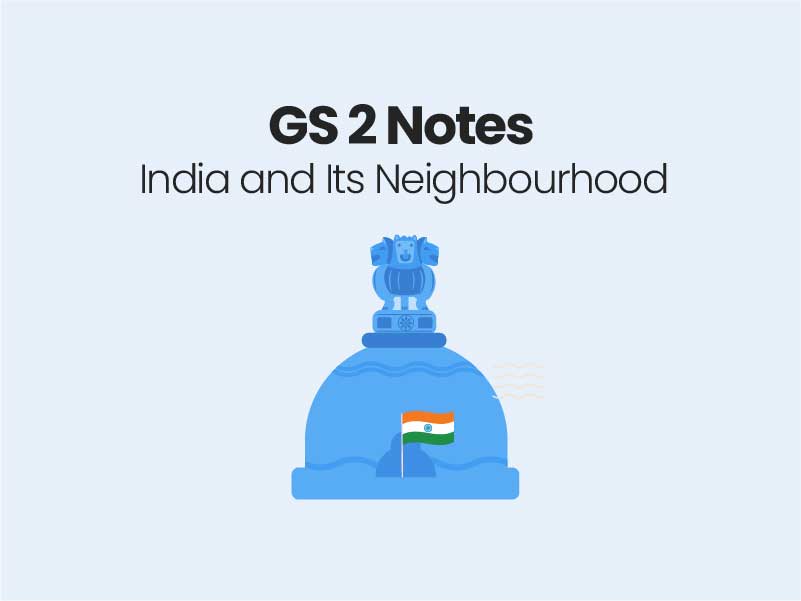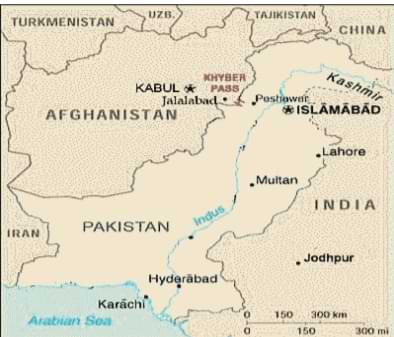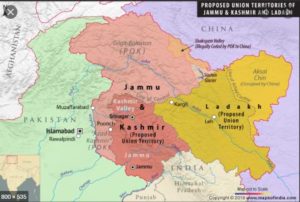Companion@360 → 7 Month programme to sharpen your writing skills → REGISTER NOW

India and Its Neighbourhood
India and Pakistan – Major Issues between India and Pakistan
Jammu and Kashmir
- The Indian Independence Act, 1947 created the Republic of India and the Islamic Republic of Pakistan. Princely states had choice to be part of two nations.
- The state of Jammu and Kasmir had an overwhelming Muslim population ruled by a Hindu King, Raja Hari Singh. The state signed standstill agreements with both India and Pakistan and wanted more time to decide the course of their future. Meanwhile, Pakistani army men dressed as tribal invaders from the North West Frontier Province invaded the state on October 22nd, 1947.
- The raja appealed to India for help on October 24th. Prime Minister Nehru on the advice of the then Governor General, Lord Mountbatten asked the Raja to sign the Instrument of Accession to India, it would not have been possible to help otherwise as India was not obliged to help any state which was not a part of it.
- The Instrument of Accession was signed on October 26th October 1947. This document proclaimed the state of Jammu and Kashmir to be an INTEGRAL part of India and surrendered three main subjects to the Central Government. The three subjects were Defence, Communications and External Affairs.
- On December 31st, 1947, India raised this issue at the United Nations. Committed to the principles of the UN Charter and believing in International Law, India thought that this was a simple issue and Pakistan would be asked to move back its troops as they were the aggressors.
- India became a victim of the cold war politics and most of the members of the UNSC took Pakistan’s side and a resolution was moved calling for a ceasefire.
- An UNMOGIP (UN Military Observers Group for India and Pakistan) was appointed.
- The Karachi Agreement of 1949 delineated the Cease Fire Line (CFL) in the state of J & K. The line is up to Point NJ 9842 beyond which lies the Siachen Glacier.
- The UN Resolution calls on both India and Pakistan to withdraw troops from Jammu and Kashmir and a plebiscite to be held once the first condition is achieved. Pakistan refused to comply with the resolution and continues to hold on to 1/3 of the territory of the state illegally.
- Pakistan has tried to unilaterally alter this position, and this had led to three wars between the two sides including 1948 (the 1971 war was fought over the liberation of East Pakistan or modern day Bangladesh. Though the fighting did take place in the western sector.
- The war of 1965 ended in a stalemate with the signing of the Tashkent Agreement in January 1966.
- The war of 1971 was not directly related to the dispute of J&K, however, there were implications. The war was called the Bangladesh Liberation war. The Indians had captured large parts of Sindh, Punjab in the western sector and had liberated East Pakistan and helped in the creation of Bangladesh.
- Prime Ministers Indira Gandhi and Bhutto met at Shimla in January 1972 and signed the Shimla Agreement. This was the best opportunity for India to have crippled the Pakistani Army and insured for a better future.
- The Shimla Agreement also converted the Cease Fire Line (CFL) into the Line of Control (LOC). It also had a clause that India and Pakistan were to work towards achieving peace and both sides would avoid vitriolic campaigns against each other.
- All disputes between the two sides were to be solved bilaterally in a peaceful manner through negotiations. Especially on this issue of J&K, India has been consistent in its position that it is a bilateral issue to be solved by India and Pakistan and there is no place for any third-party intervention.
- Pakistan believes in the exact opposite despite the Shimla Agreement. The treaty, like others, lasted only a few months before Zulfiqar Ali Bhutto continued spewing hatred against India. He is said to have issued a statement which called for bleeding India through a thousand cuts. It is a policy that the deep state continues to follow through unconventional warfare.
- Prime Ministers Atal Bihari Vajpayee and Nawaz Sharif had just concluded the Lahore Agreement of 1999. There was an atmosphere of good will which was conducive towards peace.
Importance of Jammu and Kashmir
- Ideological and Religion: As Pakistan hopes to assume the leadership of the Islamic world, Kashmir will be their stepping stone towards this objective.
- National Interests: J&K acts as a glue to keep Pakistan united. The dispute unites all people and provides a respite to the government which otherwise would have to deal with all the social tensions and insurgency related issues. The Pakistani armed forces command an undue advantage in the nation.
- Strategic Location: The state of Jammu and Kashmir shares borders with Afghanistan, China, Pakistan, and the small Wakhan Strip separates it from the Central Asian Republics. This location gives it an advantage in the geo-political sense. It has been a part of the ancient silk route.
- Resources: The entire Indus river system passes through this state and the nation which controls it gets to dictate terms advantageous to it in the Geo-political sense. Along with this other important economic activities include Tourism, Agriculture etc.
Siachen Dispute
- The Karachi Agreement of 1949 lays down the cease fire line (CFL) in the state J&K up to Point NJ 9842 on the map.
- There is confusion as to where the temporary border goes from there. The Karachi Agreement only says that the Ceasefire line shall run northwards from Point NJ 9842. India lays claim to the entire glacier due to this clause. Pakistan on the other hand insists that the ceasefire line runs eastwards from Point NJ 9842. This would grant them access to the entire glacier.
- Operation Meghdoot was launched by the Indian Army and the posts were captured in 1984 after Pakistan tried to occupy the glacier.
Why is Siachen a disputed region?
- Saltoro Ridge occupation is staking a claim beyond NJ 9842 in the event of an eventual settlement along the Line of Control and the Actual Ground Position Line.
- India has always claimed that the entire state of J&K including Northern Areas acceded to India on 26 Oct 1947. Occupation of Saltoro is therefore the occupation of Indian territory by the Indian Army. It is non-negotiable.
- If the line joining NJ 9842 to Indira Col i.e, the line along Saltoro Ridge is extended to the Indo – Tibet boundary, a major part of Shaksgam Valley illegally ceded to China by Pakistan in 1963 will fall into Indian Kashmir.
River Water Disputes:
- The Indus Waters Treaty is a water-sharing agreement between India and Pakistan signed in 1960. It was brokered by the World Bank.
- The treaty spells out conditions for water-sharing of the River Indus and its five tributaries.
- India got control over the three eastern rivers, which are:
- Ravi
- Beas
- Sutlej
- All the waters of the Eastern Rivers shall be available for the unrestricted use of India until the rise of any unwanted situation.
- Pakistan got control over the three western rivers, which are:
- Indus
- Chenab
- Jhelum
- A Permanent Indus Commission was set up by the United Nations for resolving any disputes that may arise in water sharing, with a mechanism for arbitration to resolve conflicts amicably.
- According to the treaty, India can use the water from the western rivers for domestic, non-consumptive needs such as storage, irrigation, and also the generation of electricity.
- The treaty gives India 20% of the water from the Indus River System and the rest 80% to Pakistan.
- In executing any scheme of flood protection or flood control each country(India/Pakistan) will avoid, as far as practicable, any material damage to the other country.
Indus Waters Treaty Issues
- In 2016, Pakistan had approached the World Bank raising concerns of India’s Kishenganga and Ratle hydroelectric power projects being constructed in Jammu & Kashmir.
- India then requested for neutral experts to inspect the plants, saying that the points raised by Pakistan were technical ones and do not require a court of arbitration (as Pakistan has taken it to an arbitration court).
- The World Bank permitted India to proceed with the projects after talks were concluded between both the countries on the technicalities of the treaty.
- Baglihar Hydro Power Project: This has been built on the Chenab River. It was approved in 1996, work began in 1999. The second phase of the project began in 2012 and was completed in 2015. The project is worth 900 MW. Pakistan raised this issue but did not succeed in the arbitration.
- The Tulbul project (which is a navigation lock-cum-control structure at the mouth of the Wular Lake, situated on the Jhelum from Anantnag to Srinagar and Baramulla) was suspended in 1987 after Pakistan objected to it. Recently, the government decided to review this suspension without taking into account Pakistan’s protests.
- Pakistan’s Left Bank Outfall Drain (LBOD) project passes through the Rann of Kutch in India’s Gujarat. The project was constructed without India’s consent. India has objected because this is in contravention to the IWT. The lower riparian state is in India and hence it needs to be given all details. There is also the danger of flooding in the state of Gujarat.
- Recently, the bilateral relations between India and Pakistan have taken on a downward spiral. In the wake of the Uri attacks on India, Prime Minister Modi remarked that blood and water cannot flow simultaneously indicating to Pakistan that its support to terrorism across the border will lead to India rethinking its generous stance on the IWT. Indeed, many experts believe that the treaty is more favourable towards Pakistan than India.
- To utilize the waters of the Eastern rivers which have been allocated to India for exclusive use, India has constructed Bhakra Dam on Satluj river, Pong and Pandoh Dam on Beas river, and Thein (Ranjit Sagar Dam) on Ravi river.
Options for India
- The treaty’s provisions do not allow a unilateral abrogation.
- Even if India decides to back down from the treaty, the 1969 Vienna Convention on the law of treaties should be abided by.
- This can hamper the country’s image internationally. India’s other neighbouring countries like Bangladesh and Nepal may become skeptical about similar treaties with them.
- Some experts on international affairs think that India should safeguard bilateral treaties if it is aspiring for a permanent seat in the UNSC.
- The move to abrogate the treaty may lead to more problems with respect to terrorist activities.
- India should also build adequate infrastructure to use the entire water before stopping water from Pakistan.
- Another angle is that of China. China, with its support to Pakistan, may block the water from the Brahmaputra to Assam. It can also stop the waters of the Indus which originate in Chinese territory.




